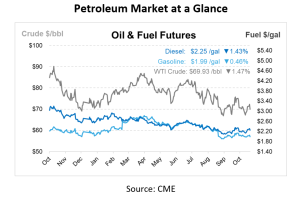
What’s That: Heating Oil
If you’re managing a business that runs on fuel, you’ve likely wondered how heating oil compares to diesel. These two fuels share a common origin, but what are the key differences? Both heating oil and diesel are derived from crude oil and have similar chemical properties, yet they serve different purposes and have distinct characteristics. Today’s What’s That Wednesday will break down the connection between them and explore the details that set them apart.
What is Heating Oil?
This oil, often referred to as No. 2 fuel oil, and diesel fuel both come from the fractional distillation process of crude oil. This process involves warming up crude oil, allowing different hydrocarbons to vaporize and condense at various temperatures. Both fuels belong to the middle distillate family, meaning their chemical compositions are closely aligned.
While chemically similar, they serve very different roles. Heating oil is a low viscosity distillate primarily used in residential and commercial heating systems such as furnaces or water heaters to warm homes and buildings. Diesel, on the other hand, powers engines in trucks, buses, heavy equipment, and even some generators.
Most of its consumption occurs in the Northeast, particularly in New England and the Central Atlantic regions. States like New York, Delaware, New Jersey, and all six New England states have transitioned to ultra-low sulfur heating oil (ULSHO), which has a sulfur content of 15 parts per million or less, making it a cleaner-burning fuel.
While most heating oil in the US is petroleum-based, some suppliers offer biofuel blends, typically containing 5% biofuel. This alternative offers a more sustainable option in certain states.
What is the difference between diesel and heating oil?
The most immediate distinction is color. Heating oil is dyed red, as required by the IRS, to differentiate it from fuels like on-road diesel, which are taxed. The dye helps prevent the improper use of heating oil, especially since it’s taxed at a lower rate compared to diesel fuel used in vehicles. It’s illegal to use heating oil in vehicles that operate on highways.
Another differentiator lies in their sulfur content. Heating oil tends to have a lower sulfur content, which leads to cleaner combustion and fewer emissions of sulfur oxides—pollutants that contribute to environmental issues such as acid rain and respiratory problems. Diesel, while also being regulated for sulfur content, generally has a higher threshold, especially in older applications.
Can They Be Swapped? Not Quite
In emergency situations, it can substitute for diesel fuel to power an engine. However, this is not a long-term solution. Heating oil lacks certain properties needed for modern diesel engines, such as proper lubrication for fuel injectors and emissions controls. Similarly, using diesel in a heating system can lead to inefficient burning, soot buildup, and potential damage to systems.
Where is it produced?
Heating oil is primarily sourced from two places: domestic US refineries and imports from other countries, particularly Canada. US refineries meet most of the country’s distillate fuel demand, while imports supplement production during peak winter months, especially in the Northeast.
Refiners produce it throughout the year, with excess amounts stored during the summer and fall to ensure supply for winter. However, production may be delayed if demand for other fuels, such as gasoline, is high, potentially leading to lower inventories at the start of the heating season.
It is moved across the US by pipelines, ships, barges, trains, and trucks. It’s typically stored in large terminals, such as those at New York Harbor, before being distributed to smaller facilities or directly to consumers by truck.
Prices

The current US price stands at $3.487, slightly up from $3.481 last week, marking a 0.17% increase. Compared to the same period last year, the price has dropped 18.74% from $4.291.

This article is part of Daily Market News & Insights
MARKET CONDITION REPORT - DISCLAIMER
The information contained herein is derived from sources believed to be reliable; however, this information is not guaranteed as to its accuracy or completeness. Furthermore, no responsibility is assumed for use of this material and no express or implied warranties or guarantees are made. This material and any view or comment expressed herein are provided for informational purposes only and should not be construed in any way as an inducement or recommendation to buy or sell products, commodity futures or options contracts.





